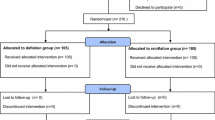Abstract
We performed a prospective, randomized study on 76 patients (82 knees) scheduled for total knee arthroplasty to determine the effect of tourniquet release and hemostasis on the peri- and postoperative blood loss. Patients were randomly divided in two groups. Posterior cruciate retaining tricompartmental total knee prostheses were used in all. In group 1, the tourniquet was deflated intraoperatively after the prosthetic components were settled and hemostasis was done. In group 2, the tourniquet was released after the wound was closed and a compressive bandage was applied. Mean blood drainage was 880.85 ml (320–1,315) in group 1 and 745.36 ml (220–1,175) in group 2 (p=0.03). The mean number of blood transfusions given, hemoglobin and hematocrit values, operation time, and tourniquet time were similar in both groups. Intraoperative tourniquet release and hemostasis does not reduce total blood loss in total knee arthroplasty.
Résumé
Nous avons exécuté une étude prospective et randomisée sur 76 malades (82 genoux) programmé pour arthroplastie du genou total pour déterminer l’effet de la levée de garrot- hémostase sur le perte de sang per—et postopératoire. Une prothèse tricompartmentale du genou, avec conservation du croisé postérieur totale a été utilisée dans tous les cas. Les malades étaient randomisés et divisés en deux groupes. Dans le groupe 1 le garrot a été dégonflé en intraopératoire après que les composants prothétiques aient été posés et l’hémostase a, alors été faite. Dans le groupe 2 le garrot a été retiré après la fermeture et la mise en place d’un pansement compressif. La perte moyenne de sang par drainage était 880.85 ml (320–1315) dans le groupe 1 et 745.36 ml (220–1175) dans le groupe 2 (p=0.03). Le nombre moyen de transfusions du sang effectuées, les valeurs de l’hémoglobine et de l’hématocrite, la durée opératoire et la durée du garrot étaient semblables dans les deux groupes.La levée du garrot pendant l’opération avec hémostase ne réduit pas la perte totale du sang dans l’arthroplastie du genou.
Similar content being viewed by others
References
Barwell NJ, Anderson G, Hassan A, Rawlings I (1997) The effects of early tourniquet release during total knee arthroplasty. A prospective randomized double-blind study. J Bone and Joint Surg [Br ] 79:265–268
Burkart BC, Bourne RB, Rorabeck CH, Kirk PG, Nott L (1994) The efficacy of tourniquet release in blood conservation after total knee arthroplasty. Clin Orthop 299:147–152
Erksine JG, Fraser C, Simpson R, Protheroe K, Walker ID (1981) Blood loss with knee joint replacement. J Roy Coll Surg Edinburgh 26:295–297
Harvey EJ, Leclerc J, Brooks CE, Burke DL (1997) Effect of tourniquet use on blood loss and incidence of deep vein thrombosis in total knee arthroplasty. J Arthroplasty 12:291–296
Jorn LP, Lindstrand A, Toksvig-Larsen S (1999) Tourniquet release for hemostasis increases bleeding. A randomized study of 77 knee replacements. Acta Orthop Scand 70:265–267
Lotke PA, Faralli VJ, Orenstein EM, Ecker ML (1991) Blood loss after total knee replacement:effects of tourniquet release and continuous passive motion. J Bone Joint Surg [Am] 73:1037–1040
Mylod AG, France MP, Muser DE, Parsons JR (1990) Perioperative blood loss associated with total knee arthroplasty. A comparison of procedures performed with and without cementing. J Bone and Joint Surg [Am] 72:1010–1012
Newman JH, Jackson JP, Waugh W (1979) Timing of tourniquet removal after knee replacement. J Roy Soc Med 72:492–494
Page MH, Shepard BD, Harrison JM (1984) Reduction of blood loss in knee arthroplasty. Aust N Z J Surg 54:141–144
Pattison E, Protheroe K, Pringle RM, Kennedy AC, Dick WC (1973) Reduction in haemoglobin after knee joint surgery. Ann Rheumat Dis 32:582–584
Rand JA (1987) Vascular complications of total knee arthroplasty. Report of three cases. J Arthroplasty 2:89–93
Salam AA, Eyres KS (1995) Effects of tourniquet during total knee arthroplasty. J Bone and Joint Surg [Br] 77:250–253
Vandenbussche E, Duranthon LD, Couturier M, Pidhorz L, Augereau (2002) The effect of tourniquet use in total knee arthroplasty. Int Orthop 26:306–309
Widman J, Isacson J (1999) Surgical hemostasis after tourniquet release does not reduce blood loss in knee replacement. A prospective randomized study of 81 patients. Acta Orthop Scand 70:268–270
Author information
Authors and Affiliations
Corresponding author
Rights and permissions
About this article
Cite this article
Hersekli, M.A., Akpinar, S., Ozkoc, G. et al. The timing of tourniquet release and its influence on blood loss after total knee arthroplasty. International Orthopaedics (SICOT) 28, 138–141 (2004). https://doi.org/10.1007/s00264-004-0550-5
Accepted:
Published:
Issue Date:
DOI: https://doi.org/10.1007/s00264-004-0550-5




